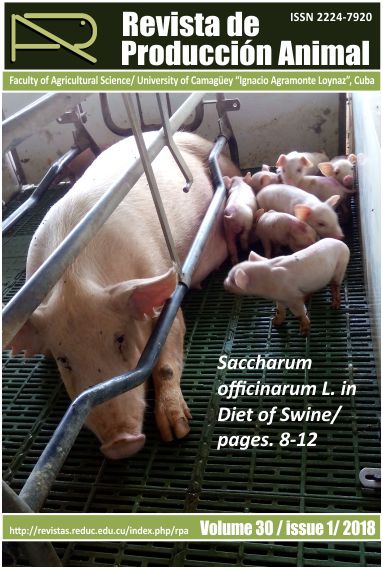Fodder, Nitrogen, and Energy Balances in Grasslands with Algarroba Trees (Prosopis juliflora (S.W.) DC.) under Dairy Cow Grazing
Resumen
The purpose of this study was to evaluate the effect of algarroba (Prosopis juliflora (S.W.) DC.) on fodder, nitrogen and energy contents in Ecuadoran dairy farm grasslands. The study was made at ESPAM bovine facility, 15 meters above sea level, in Manabí, 00º49’23’’, south latitude, and 80º11’01” west longitude, with 962.4 mm of annual precipitation, between September 2011 and December 2014. The stocking rate was 1.09 LU/ha. The areas were populated with 1-4 algarroba trees/ha by 2011, and 8-35 trees/ha, in 2014. Fodder, nitrogen, and energy balances depended on the arborization degree. As a result, 52 t of DM were estimated in 2014, in comparison to the 21 t produced in 2011. Nitrogen was higher with increased arborization between 2011 (60.9 kg/ha), greater nutrient intake from external sources, and 2014 (39.3 kg/ha), with less use of supplements and mineral fertilizers, and greater N2 contribution by arborization. The energy values were higher in 2014, with an increase in algarroba population/ha. The rise in trees/ha in 2014 favored forage yields, with improved N2 and energy efficiency, which was linked to the benefits acquired by the grassland, the contribution of nitrogen to the ecosystem, and the reduction in feed and fertilizer consumption, which led to energy savings.
Descargas
Los autores de los artículos publicados en RPA retienen los derechos de autor de su trabajo, de marca y patente, y también sobre cualquier proceso o procedimiento descrito en el artículo, así como a compartir, copiar, distribuir, ejecutar y comunicar públicamente el artículo publicado en la RPA o cualquier parte de aquel siempre que indiquen la fuente de publicación (autores del trabajo, revista, volumen, número y fecha), pero están de acuerdo en que la revista publique los trabajos bajo una licencia Creative Commons.
![]() Licencia Attribution-NonCommercial 4.0 International (CC BY-NC 4.0)
Licencia Attribution-NonCommercial 4.0 International (CC BY-NC 4.0)






































